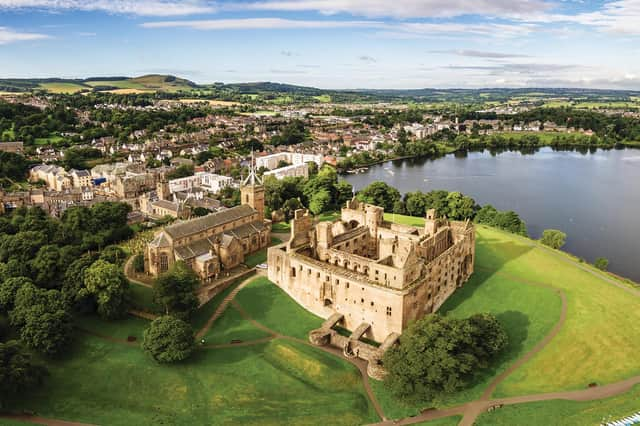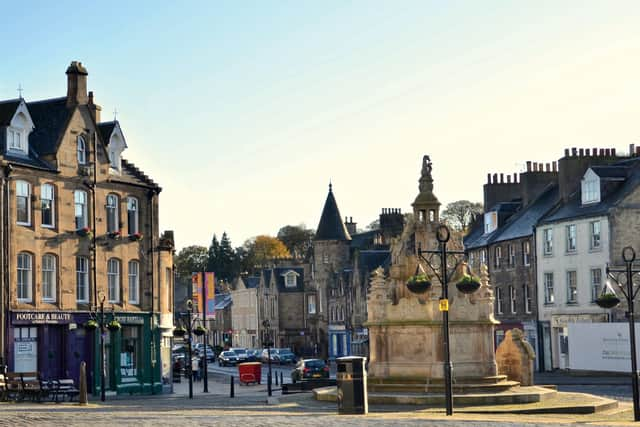Area focus: Linlithgow


The event, promoted by Scottish Gin Festivals, will showcase 100 per cent Scottish craft gins, tonics and artisan tapas, in a programme that has been carefully curated to the location. The festival will run between 1pm and 11pm at the iconic A-listed venue at The Cross, on the picturesque cobbled Kirkgate, which is worth a visit in itself.
The surrounding traditional stone buildings are just as noble, with stepped gables and baronial-style turrets, in keeping with much of the centre of town.
Advertisement
Hide AdAdvertisement
Hide AdAnd anyone who knows much about Linlithgow’s rich history won’t be surprised by its wealth of majestic architecture.


The town’s name stems from the loch to its the north, and is derived from the Brythonic term for “lake in the damp hollow”.
Perhaps one of the most important places in Scottish history, Linlithgow was a seat of residence for Kings and Queens as far back as King David I’s reign during 1124-53, when it was made a Royal Burgh.
Most notably, Linlithgow Palace, the current structure of which was begun by the Stewarts in 1424, was the birthplace of King James V and Mary Queen of Scots.
Situated approximately halfway between Stirling and Edinburgh, which shared the designation of capital city until the 16th-Century, it was inevitable a town would flourish there.
By the 17th-Century, Linlithgow’s economy was built largely on leather and papermaking, and the completion of the Union Canal between Glasgow and Edinburgh in 1822, helped trade soar.
These days, the town is popular with homebuyers looking to commute, as journeys to the Capital take just 20 minutes by rail, or 40 by car; and it is just a half hour to Glasgow by train, or 45 minutes on the M9.
A home in the town – twinned with the French town of Guyancourt, near Paris – has an average market value of £280,074, according to Zoopla, which is a rise of 4.41 per cent on the year previous.
Advertisement
Hide AdAdvertisement
Hide AdTo accommodate this demand, developers have been creating new housing estates around Linlithgow’s outskirts and neighbouring communities in recent years.
The latest is Cala Homes’ impressive Queenswood site in the north west of the town.
Other modern residential developments include the selection of large detached villas on Kettil’Stoun Mains. A four-bedroomed home here will fetch more than £480,000.
Avalon Gardens at Linlithgow Bridge is similarly attractive to families seeking a home designed for modern living with gardens and garages, and homebuyers can expect to pay around £359,666 for a property there.
The nearby Clark Avenue also features many picturesque modern detached homes.
However, for those seeking to buy a slice of Linlithgow’s rich heritage, the central Royal Terrace and Strawberry Bank feature a variety of unique 19th-Century houses, some of which have now been converted into apartments or guest houses.
Demand for a property at these prestigious addresses is evident, having been valued at an average £592,645 and £372,141, respectively.
Linlithgow’s quaint High Street is home to a number of flats situated above the thoroughfare’s many varied shops and, with an average price tag of £180,081, they are ideal for first-time buyers or those seeking a second home.
Advertisement
Hide AdAdvertisement
Hide AdThe High Street’s retail and leisure opportunities include cafés and a gallery, as well as supermarkets such as Sainsbury’s, Aldi and Tesco.
The well-regarded Linlithgow Academy is the town’s authority-run secondary school and primary schools include Linlithgow Bridge, St Joseph’s RC, Springfield and Linlithgow Primary.
In addition, a variety of independent alternatives are within easy commuting distance.
Average market value of a property in the area (Source: Zoopla)
Detached £454,273
Semi-detached £250,863
Terrace £206,520
Flat £166,990
Attractions
Linlithgow Palace is obviously the town’s most famous landmark, perched high on the banks of Linlithgow Loch. King James I ordered work to begin on the palace in 1424 to replace a previous residence ruined by fire. It served as home for many kings and queens and is best known as the birthplace of James V, Mary Queen of Scots and Princess Elizabeth, all in the 16th Century. Visitors today can discover what life was like for the royalty who lived there and admire the breathtaking views across the loch. Although the site is temporarily closed, it is expected to open again soon and its exterior can still be observed. Find out more online at historicenvironment.scot
Linlithgow Museum can be found on the first floor of the Partnership Centre in Tam Dalyell House on the High Street. The museum reveals the community’s royal connections, its heritage and how its people have lived throughout the centuries. It is open on Fridays, Saturdays and Sundays, and time slots can be booked on its website at www.linlithgowmuseum.org
Kinneil House at Bo’ness, pictured left, is a ten-minute drive away and was the seat of the aristocratic Hamilton family after they bought the lands in 1323. The exterior and its grounds can be admired by sightseers, although its interior is only open on a handful of days throughout the year with timed guided tours available. For more information, go online and visit kinneil.org